Revelation 10 – The Seven Thunders-The Little Book and the
Origins of the Seventh Day Adventist Church
This 6 part series on Revelation 10 and the origins of the Seventh Day Adventist Church is presented by Pastor Stephen Bohr of Secrets Unsealed. This is a must watch series, not just for Seventh Day Adventist’s but for all students of prophecy. This series provides information on Revelation and Daniel which is not commonly taught in any of the Churches, including the Seventh Day Adventist church so I highly recommend this series.
The following text is a partial transcript from part 2 of the series; I have included it for the reader to in the hope that you might garnish an insight to the study prior to watching the series.
There’s no passage in scripture that better describes the origin, the identity, the message, the mission, and the destiny of the seventh-day Adventist Church, than Revelation 10.
Traditionally, philosophy has asked three main questions; where do I come from, why am I here, and where am I going?
Now we need to ask these same three questions about our own Seventh-Day Adventist Church, where did we come from why are we here, and what will our final destiny be?
If we don’t know our roots, we will not realize the immense privilege of belonging to the Seventh-Day Adventist Church, and we will fail to realize what our message and mission are.
We will feel no particular pride in belonging to this Church, and we will come to the conclusion that this is just one Church among many.
These days some of the intelligentsia; those are the highly educated in our midst, are embarrassed about the origin of our church, they have concluded that the Pioneers were a group of uneducated individuals, who had no higher education degrees, and therefore were highly deficient in their theology.
Like the leaders of the Jewish Sanhedrin perceived Peter and John they, perceived that the Pioneers were uneducated and untrained.
Some liberal publications such as spectrum, and Adventist today, and probably some of you are acquainted with these very liberal publications that mostly come out of Loma Linda.
They would just as soon erase from our history, the sanctuary, 1844, and the great disappointment. In fact, these publications would like the Seventh-Day Adventist Church to be just like every other Church, perhaps with a little sprinkling of doctrines that are different, like for example the Sabbath.
This is a great tragedy, because if we don’t know the prophecies that have made us the people that we are, we will simply come to the conclusion that our church is one among many, and there are many in the Adventist Church that have reached that conclusion, that we are one Church among many, and therefore we should all join forces with all of the other Christian churches.
In this study of Revelation 10, we will allow the Bible to explain itself; by comparing one text with another, that’s the traditional Seventh-Day Adventist method, it’s being criticized today as the proof text method, but the holy spirit has placed within the Bible everything we need to understand the Bible, because the Holy Spirit superintended the composition of Scripture.
He put in Scripture everything that we need to understand scripture, which means that theologians are not Indispensable, commentaries are not indispensable. I’m not saying that it’s bad to read commentaries, I’m not saying that it’s wrong for us to listen to theologians make presentations.
What I’m saying is that if there were no commentaries, and there were no theologians we could understand the Bible within itself, because the Holy Spirit placed within the Bible everything we need to understand the Bible, and that’s true of this passage in Revelation 10.
Everything we need to understand of Revelation 10 is found within scripture itself.
Now there’s one point I want to emphasize; as we begin this study we will see that Revelation 10 describes the origins of the great Advent movement in minute detail, and as we move along you will also notice that I will use the spirit of prophecy to support many details in our interpretation, and of course this leads us to our next section.
Why use Ellen White?
On a certain occasion; this was just a few months ago I was presenting this series in a Spanish speaking Church in Charlotte North Carolina, and after I made the presentation a lady came up to me; a Church member, she was very sincere, she wasn’t being facetious or nasty.
She says: If I wish to give this study of Revelation chapter 10 to a person who is not an Adventist; how could I do it simply by using the Bible, and not referring to Ellen White?
The implication of the question was that a non Adventist would never accept Ellen White as an authority to interpret the prophecy of Revelation 10. She was right; a non Adventist who was not versed in the theology of the Adventist Church would not accept Ellen White as an authority if you were to quote her.

1of6 The Seven Thunders The Little Book and the SDA Church Origins

2of6 The Seven Thunders The Little Book and the SDA Church Origins

3of6 The Seven Thunders The Little Book and the SDA Church Origins

4of6 The Seven Thunders The Little Book and the SDA Church Origins

5of6 The Seven Thunders The Little Book and the SDA Church Origins

6of6 The Seven Thunders The Little Book and the SDA Church Origins
-
1of6 The Seven Thunders The Little Book and the SDA Church Origins
There's no passage in scripture that better describes the origin, the identity, the message, the mission, and the destiny of the seventh-day Adventist Church than Revelation chapter 10. These days some of the intelligentsia; those are the highly educated in our midst, are embarrassed about the origin of our church, they have concluded that the Pioneers were a group of uneducated individuals who had no higher education degrees, and therefore were highly deficient in their theology. Just like the leaders of the Jewish Sanhedrin perceived Peter and John, they perceive that the Pioneers were uneducated and untrained. Some liberal publications such as Spectrum, and Adventist Today, and other very liberal publications that mostly come out of Loma Linda would just as soon erase from our history, the sanctuary, 1844, and the great disappointment. In fact, these publications would like the seventh-day Adventist Church to be just like every other Church, perhaps with a little sprinkling of doctrines that are different, like for example the Sabbath. In this study of Revelation 10, we will allow the Bible to explain itself; by comparing one text with another, that's the traditional seventh-day Adventist method, it's being criticized today as the proof text method, but the holy spirit has placed within the Bible everything we need to understand the Bible, because the Holy Spirit superintended the composition of Scripture. watchmanministries.net secretsunsealed.org https://www.youtube.com/user/secretsu... -
2of6 The Seven Thunders The Little Book and the SDA Church Origins
There's no passage in scripture that better describes the origin, the identity, the message, the mission, and the destiny of the seventh-day Adventist Church than Revelation chapter 10. These days some of the intelligentsia; those are the highly educated in our midst, are embarrassed about the origin of our church, they have concluded that the Pioneers were a group of uneducated individuals who had no higher education degrees, and therefore were highly deficient in their theology. Just like the leaders of the Jewish Sanhedrin perceived Peter and John, they perceive that the Pioneers were uneducated and untrained. Some liberal publications such as Spectrum, and Adventist Today, and other very liberal publications that mostly come out of Loma Linda would just as soon erase from our history, the sanctuary, 1844, and the great disappointment. In fact, these publications would like the seventh-day Adventist Church to be just like every other Church, perhaps with a little sprinkling of doctrines that are different, like for example the Sabbath. In this study of Revelation 10, we will allow the Bible to explain itself; by comparing one text with another, that's the traditional seventh-day Adventist method, it's being criticized today as the proof text method, but the holy spirit has placed within the Bible everything we need to understand the Bible, because the Holy Spirit superintended the composition of Scripture. watchmanministries.net secretsunsealed.org https://www.youtube.com/user/secretsu... -
3of6 The Seven Thunders The Little Book and the SDA Church Origins
There's no passage in scripture that better describes the origin, the identity, the message, the mission, and the destiny of the seventh-day Adventist Church than Revelation chapter 10. These days some of the intelligentsia; those are the highly educated in our midst, are embarrassed about the origin of our church, they have concluded that the Pioneers were a group of uneducated individuals who had no higher education degrees, and therefore were highly deficient in their theology. Just like the leaders of the Jewish Sanhedrin perceived Peter and John, they perceive that the Pioneers were uneducated and untrained. Some liberal publications such as Spectrum, and Adventist Today, and other very liberal publications that mostly come out of Loma Linda would just as soon erase from our history, the sanctuary, 1844, and the great disappointment. In fact, these publications would like the seventh-day Adventist Church to be just like every other Church, perhaps with a little sprinkling of doctrines that are different, like for example the Sabbath. In this study of Revelation 10, we will allow the Bible to explain itself; by comparing one text with another, that's the traditional seventh-day Adventist method, it's being criticized today as the proof text method, but the holy spirit has placed within the Bible everything we need to understand the Bible, because the Holy Spirit superintended the composition of Scripture. watchmanministries.net secretsunsealed.org https://www.youtube.com/user/secretsu... -
4of6 The Seven Thunders The Little Book and the SDA Church Origins
There's no passage in scripture that better describes the origin, the identity, the message, the mission, and the destiny of the seventh-day Adventist Church than Revelation chapter 10. These days some of the intelligentsia; those are the highly educated in our midst, are embarrassed about the origin of our church, they have concluded that the Pioneers were a group of uneducated individuals who had no higher education degrees, and therefore were highly deficient in their theology. Just like the leaders of the Jewish Sanhedrin perceived Peter and John, they perceive that the Pioneers were uneducated and untrained. Some liberal publications such as Spectrum, and Adventist Today, and other very liberal publications that mostly come out of Loma Linda would just as soon erase from our history, the sanctuary, 1844, and the great disappointment. In fact, these publications would like the seventh-day Adventist Church to be just like every other Church, perhaps with a little sprinkling of doctrines that are different, like for example the Sabbath. In this study of Revelation 10, we will allow the Bible to explain itself; by comparing one text with another, that's the traditional seventh-day Adventist method, it's being criticized today as the proof text method, but the holy spirit has placed within the Bible everything we need to understand the Bible, because the Holy Spirit superintended the composition of Scripture. watchmanministries.net secretsunsealed.org https://www.youtube.com/user/secretsu... -
5of6 The Seven Thunders The Little Book and the SDA Church Origins
There's no passage in scripture that better describes the origin, the identity, the message, the mission, and the destiny of the seventh-day Adventist Church than Revelation chapter 10. These days some of the intelligentsia; those are the highly educated in our midst, are embarrassed about the origin of our church, they have concluded that the Pioneers were a group of uneducated individuals who had no higher education degrees, and therefore were highly deficient in their theology. Just like the leaders of the Jewish Sanhedrin perceived Peter and John, they perceive that the Pioneers were uneducated and untrained. Some liberal publications such as Spectrum, and Adventist Today, and other very liberal publications that mostly come out of Loma Linda would just as soon erase from our history, the sanctuary, 1844, and the great disappointment. In fact, these publications would like the seventh-day Adventist Church to be just like every other Church, perhaps with a little sprinkling of doctrines that are different, like for example the Sabbath. In this study of Revelation 10, we will allow the Bible to explain itself; by comparing one text with another, that's the traditional seventh-day Adventist method, it's being criticized today as the proof text method, but the holy spirit has placed within the Bible everything we need to understand the Bible, because the Holy Spirit superintended the composition of Scripture. watchmanministries.net secretsunsealed.org https://www.youtube.com/user/secretsu... -
6of6 The Seven Thunders The Little Book and the SDA Church Origins
There's no passage in scripture that better describes the origin, the identity, the message, the mission, and the destiny of the seventh-day Adventist Church than Revelation chapter 10. These days some of the intelligentsia; those are the highly educated in our midst, are embarrassed about the origin of our church, they have concluded that the Pioneers were a group of uneducated individuals who had no higher education degrees, and therefore were highly deficient in their theology. Just like the leaders of the Jewish Sanhedrin perceived Peter and John, they perceive that the Pioneers were uneducated and untrained. Some liberal publications such as Spectrum, and Adventist Today, and other very liberal publications that mostly come out of Loma Linda would just as soon erase from our history, the sanctuary, 1844, and the great disappointment. In fact, these publications would like the seventh-day Adventist Church to be just like every other Church, perhaps with a little sprinkling of doctrines that are different, like for example the Sabbath. In this study of Revelation 10, we will allow the Bible to explain itself; by comparing one text with another, that's the traditional seventh-day Adventist method, it's being criticized today as the proof text method, but the holy spirit has placed within the Bible everything we need to understand the Bible, because the Holy Spirit superintended the composition of Scripture. watchmanministries.net secretsunsealed.org https://www.youtube.com/user/secretsu...
In my answer to her I underlined two main points; first of all, I would never give the study of Revelation 10 to a non Adventist as the first Bible study that I give them. We are not like the Mormons: Have you ever had Mormons visit your home, what is the first study that the Mormons give you? About the whole history of the Mormon Church, the golden plates, the angel Moroni, the Book of Mormon, they lay it all out in the first study; because they want you to accept the authority of the Book of Mormon, and Doctrine and Covenants and pearl of great price, they want to use those sources besides the Bible in the studies that they’re going to give you after that. So the first thing is believe in our Prophet.
In the Adventist church we don’t do it that way; at least we shouldn’t. What we do in the Adventist Church is we present all of our message from the Bible, and then we present the spirit of prophecy after we have presented everything, and then say, God has given us an additional blessing, someone to amplify, to explain, and to correct us when we go astray from the correct biblical interpretation. So my first point to her was that I would not give this Bible study to someone who is not well-versed in the sanctuary, we’d have to study the sanctuary with them first, we will have to study the 2300 day prophecy with them, and we would have to of course speak to them about the role of the Spirit of Prophecy in the Remnant Church. Only then would they be ready to receive a study on Revelation 10. My second point was that it’s not fair that this study be presented from the Bible alone, it’s not fair for someone to say I want you to present the prophecy of Revelation 10 from the Bible alone, let me explain what I mean by giving you a couple of examples.
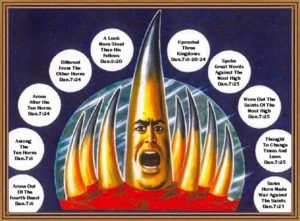 In Daniel 7 and revelation chapter 13 you have the prophecy about the little horn and the Beast. What does the little horn and what does the Beast represent? It represents the Roman Catholic papacy, firstly, we need to make a distinction between the papacy and the Roman Catholic Church; there’s a difference, the Roman Catholic Church is one thing and the papacy is another. The papacy is the union of church and state, you know when we speak about the deadly wound we say the Catholic Church received the deadly wound.
In Daniel 7 and revelation chapter 13 you have the prophecy about the little horn and the Beast. What does the little horn and what does the Beast represent? It represents the Roman Catholic papacy, firstly, we need to make a distinction between the papacy and the Roman Catholic Church; there’s a difference, the Roman Catholic Church is one thing and the papacy is another. The papacy is the union of church and state, you know when we speak about the deadly wound we say the Catholic Church received the deadly wound.
No! The Catholic Church did not receive the deadly wound, the papacy did, because the church was separated from the state, the state turned against the church so there was no longer any papacy, but there was a Roman Catholic Church.
Were the Catholic Churches closed in 1798, could people still take their children to be baptized, could people still go to the confessional, was mass still celebrated? Yes! So was the deadly wound given to the Catholic Church, as a church? No!
It was given to the papacy, see we need to be precise in our interpretation because you know if you say it was given to the Roman Catholic Church then you need to ask did the Roman Catholic Church actually cease to exist in 1798, was the church dead? No! The papacy was dead, because the papacy could no longer use the power of the state to do what it did during the 1260 years.
Revelation chapter 13, and Daniel 7 speak about the beast and the little horn; we believe it represents the Roman Catholic papacy. Can you prove that using the Bible alone? No!
You say: What do you mean? Listen, the papacy came into existence after the Canon of Scripture was closed. The year was 538, by that time the Canon of Scripture was complete, so this is a post canonical prophecy.
How do we know that it’s the Roman Catholic Papacy? The Bible doesn’t say it’s the Roman Catholic Papacy, so what do we do?
We look for all of the characteristics in the Bible, now we’re not going beyond the Bible. We’re going from the Bible to history, but the Bible gives us the characteristics that we are to look for. So we look at the little horn, and we find that it persecuted the Saints of the Most High, it spoke blasphemies against the Most High, it thought it could change times and laws. Revelation 13 adds that it tramples the sanctuary, those who dwell in heaven etc, and it rules for 1260 years. (An excellent series to study these prophecies are the ‘Three Angels Messages’ which is another presentation by Pastor Stephen Bohr)
So what do we do? We take all those characteristics and we look for the fulfillment in history beyond the biblical canon. Is that legitimate? Of course it is.
let’s take a second example; Is the United States contemplated in Bible prophecy? So show me the verse where it says the United States of America?
It’s nowhere to be found. Would it be fair to say that because the Bible doesn’t say ‘United States of America’ that the United States of America is not in Bible prophecy? That’d be ridiculous. What do we do with the prophecy of revelation 13 verses 11 to 18? Once again we look at all the characteristics of this beast that rises from the earth, the two horns like a lamb, when it rises, where it rises, what its characteristics are, and once we have all of the characteristics, all we do is go to history to find which system all of those characteristics apply.
The same can be said about Revelation 10, and in this chapter we find the characteristics are point after point, link after link, you’re going to be amazed at how everything was fulfilled in its proper order, every detail of this chapter. It describes in minute detail, the origin and the rise of the remnant Church, that is the Seventh-Day Adventist Church.
But we must find the fulfillment in history, you have to look at the characteristics in Revelation 10, and then you have to go to history to find out what movement arose in fulfillment of this prophecy. Is that legitimate? Of course it’s legitimate; we do it with the little horn, we do it with the beast, we do it with the beast from the earth, so how can you say that we can’t do it with Revelation 10?
Now; it needs to be emphasized that the writings of Ellen White and the pioneers are a particular authority when it comes to Revelation 10, they are a special authority because they were eyewitnesses. Ellen White does not write as a historian about something that happened that she did not participate in. In her writings she describes things as they happened, she was there, and the pioneers were there, so they are a particular authority because they’re not writing simply as historians, they’re writing as eyewitnesses to those events, and I’d like to say that one of the deficiencies that I see in Seventh-Day Adventist evangelism, is that hardly ever do we go into denominational history for someone to become a Seventh-Day Adventist.
I’ve been to many evangelistic series in recent years, and I don’t remember any evangelist dealing with the prophecy of Revelation 10, yes the 2300 days of the little horn, the Beast, the United States in prophecy, some will even go into Revelation chapter 17, the harlot that’s riding this dragon beast, the Scarlet beast, but not Revelation 10. In many years I’ve never seen any presentation on this chapter, and it’s the most important chapter for people to identify with the remnant Church, and really bond with the church. And let me say that even if they didn’t have any friends in the church, I think it’s important for people who come into the church to have friends bonding with individuals that will keep them in the church, but I believe that when they understand that this is a prophetic movement, they will stick no matter what. But we’re not teaching them denominational history, many times we’re not even teaching them some of the distinctive doctrines of the church.
Now let’s take a look at this passage having said what I have, now that I have permission to go beyond the Canon of Scripture, and I’ve given the explanation why we need to look for the historical fulfillment of Revelation 10.
Traditionally; the Seventh-Day Adventist Church have correctly interpreted the trumpets as a sequence of events in the flow of the history of the Christian Church, the first trumpet of course would begin in apostolic times, and then all the trumpets fulfilled throughout church history, culminating with Christ taking over his everlasting kingdom, the second coming, which is the historicist method.
That’s the Adventist’s method of interpreting prophecy, the Christian world is so goofed up because they forgot the method, they don’t have the manual so all they can do is guess, so what is the little horn, well that has to be some nasty individual that’s going to rise in the Middle East, he’s going to rebuild the Jewish temple, he’s going to make a big statue of himself, he’s going to command everyone to bow before the statue, and he’s going put a tattoo on people’s foreheads or right hand.
But there’s no context to the little horn, they just say this is what it means, but in order to know who the little horn is you have to follow the sequence, lion, bear, leopard, dragon, ten horns, little horn. You have to follow the order, you have to follow the sequence of prophetic events, then you’re not going to take the little horn out of the picture and project him to the future, when really the little horn was fulfilled in the past; so we need to understand the prophetic chain.
Now the events of Revelation 10 are taking place during the period of the sixth trumpet. How many trumpets are there? Seven! So would you agree with me that this must be something that’s taking place at the time of the end? Because if it was apostolic times, which trumpet would it be? It would be the first, if it was about the middle ages which trumpet would you expect? Somewhere in the middle, but we’re talking about trumpet number six, there’s only one more trumpet left, and that trumpet is when Jesus takes over the kingdoms of the world, so this is the trumpet that sounds immediately before the close of probation, and Jesus takes over the kingdoms of this world. We have a historical reference point to know when Revelation 10 is fulfilled, it’s fulfilled in the time of the end.
Go to the 30 minute and 32 second point of part 2 of the series to pick up where this text leaves off.

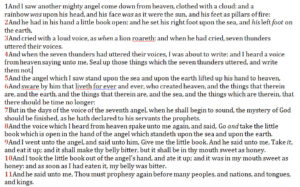

 In Chapter Four of Love Wins, Bell criticizes some statements of faith that he has taken from evangelical church websites that reflect Jesus’ teachings on Hell: “The unsaved will be separated forever from God in hell.” After giving a number of examples with which he feels uncomfortable, Bells states,
In Chapter Four of Love Wins, Bell criticizes some statements of faith that he has taken from evangelical church websites that reflect Jesus’ teachings on Hell: “The unsaved will be separated forever from God in hell.” After giving a number of examples with which he feels uncomfortable, Bells states, 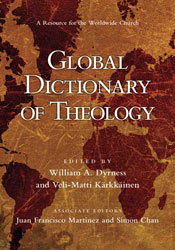 The emergent-friendly, Global Dictionary of Theology, makes a distinction between ‘Hopeful Universalism’ and ‘Convinced Universalism’:
The emergent-friendly, Global Dictionary of Theology, makes a distinction between ‘Hopeful Universalism’ and ‘Convinced Universalism’: Indeed, in the very preface of Love Wins, Bell contradicts Jesus’ teaching that few would actually be saved. Bell writes:
Indeed, in the very preface of Love Wins, Bell contradicts Jesus’ teaching that few would actually be saved. Bell writes: It is a sobering thought that Jesus went on to state in the verses immediately following His teaching on the narrow and broad roads, that false prophets would come in sheep’s clothing (Matthew 7:15-21). Such false prophets stand at the cross roads between the broad and narrow road, claiming to represent Christ, while pointing their followers toward the broad road that leads destruction, assuring them that it eventually leads to Heaven. Consider this for a minute. Isn’t this exactly what Rob Bell is doing?
It is a sobering thought that Jesus went on to state in the verses immediately following His teaching on the narrow and broad roads, that false prophets would come in sheep’s clothing (Matthew 7:15-21). Such false prophets stand at the cross roads between the broad and narrow road, claiming to represent Christ, while pointing their followers toward the broad road that leads destruction, assuring them that it eventually leads to Heaven. Consider this for a minute. Isn’t this exactly what Rob Bell is doing? Rob Bell not only redefines Hell by teaching that it will only be a temporary abode for those who want to leave later, but he redefines Hell by claiming that it is not so much about the after life, but it’s about what you make of the life here and now. In his book, Velvet Elvis, Bell had already stated this position:
Rob Bell not only redefines Hell by teaching that it will only be a temporary abode for those who want to leave later, but he redefines Hell by claiming that it is not so much about the after life, but it’s about what you make of the life here and now. In his book, Velvet Elvis, Bell had already stated this position: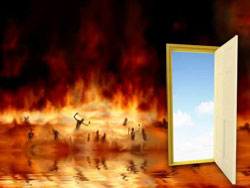 Rob Bell takes every possible liberty to deny reality and to either explain Hell away or get everyone into Heaven, regardless of his or her rejection of God and the Gospel. Bell not only empties Hell of God’s holy wrath, he creates an exit door from the inside out and claims that Hell is merely what we make it. He also claims that most of the imagery of future judgments in Hell were fulfilled on earth in AD 70 (p. 81).
Rob Bell takes every possible liberty to deny reality and to either explain Hell away or get everyone into Heaven, regardless of his or her rejection of God and the Gospel. Bell not only empties Hell of God’s holy wrath, he creates an exit door from the inside out and claims that Hell is merely what we make it. He also claims that most of the imagery of future judgments in Hell were fulfilled on earth in AD 70 (p. 81).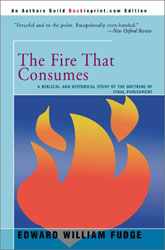 By claiming that the unrepentant wicked will have a chance to get to Heaven from Hell, Rob Bell has gone beyond that of Edward W. Fudge, who states in The Fire That Consumes,
By claiming that the unrepentant wicked will have a chance to get to Heaven from Hell, Rob Bell has gone beyond that of Edward W. Fudge, who states in The Fire That Consumes, 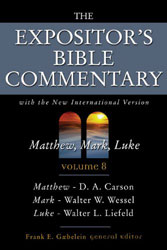 Biblical Scholar D.A. Carson, commenting on Matthew 25:46, says :
Biblical Scholar D.A. Carson, commenting on Matthew 25:46, says :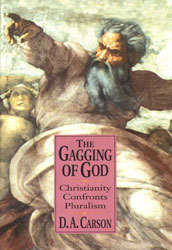 “What is hard to prove, but seems to me probable, is that one reason why the conscious punishment of hell is ongoing is because sin is ongoing.”
“What is hard to prove, but seems to me probable, is that one reason why the conscious punishment of hell is ongoing is because sin is ongoing.” There is hardly any wiggle room for a second chance in hell in these passages or anywhere in Scripture. Bell would have his readers believe of the book of Revelation that
There is hardly any wiggle room for a second chance in hell in these passages or anywhere in Scripture. Bell would have his readers believe of the book of Revelation that  May God give us the grace, in these times of apostasy, to hold fast to Jesus’ teachings and remain faithful to our loving and Holy Lord to the end. May God deliver His bride from the cotton candy Christianity that is endemic in Emergent Churches and among false prophets who lead the lost into believing they can put off repentance until after death.
May God give us the grace, in these times of apostasy, to hold fast to Jesus’ teachings and remain faithful to our loving and Holy Lord to the end. May God deliver His bride from the cotton candy Christianity that is endemic in Emergent Churches and among false prophets who lead the lost into believing they can put off repentance until after death.